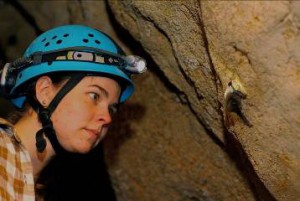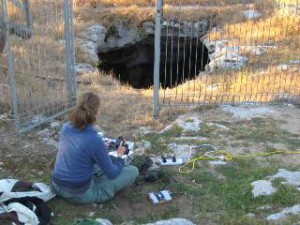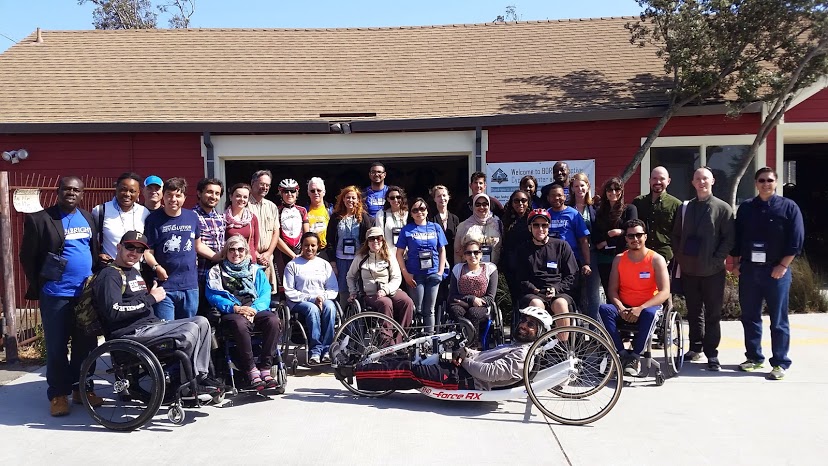
Kristen Lear, 2011-2012, Australia, with a Southern Bent-wing Bat (Miniopterus schreibersii bassanii) in Bat Cave, Naracoorte, South Australia
Happy Halloween! In honor of the Fulbright Program celebrating #BatWeek on Twitter, today’s blog post is from Fulbright U.S. Student Program alumna Kristen Lear, who studied the conservation of the Southern Bent-wing Bat in Australia back in 2011. Enjoy!
The wind stirs as I sit under the bright stars and listen to the rustle of bat wings as they flit past me. The bright screens of my laptop and the thermal imaging camera are the only lights shining in the dark. The stream of bats gets heavier until there are over 1,000 flying out of the cave every minute. I spend most nights like this, sitting outside Bat Cave at Naracoorte Caves National Park, South Australia, taking fly-out counts to determine the population size of Southern Bent-wing Bats (Miniopterus schreibersii bassanii). The aim of my Fulbright project is to monitor the bats at the maternity cave (Bat Cave) and at their overwintering sites throughout South East South Australia.
The Southern Bent-wing Bat was listed as Critically Endangered under Australia’s Environment Protection and Biodiversity Conservation Act of 1999 based on the fact that the sub-species has undergone a reduction in population by about 67 percent over three generations (from about 100,000-200,000 bats in the 1960s to about 30,000 in 2009) and that it has a highly restricted range, relying on only two maternity caves (Bat Cave in Naracoorte and Starlight Cave in Warrnambool, Victoria). During my Fulbright year, I have been taking regular fly-out counts with thermal imaging cameras to monitor population trends at Bat Cave and determine the peak population size, monitor pup health to watch for signs of disease or starvation and conduct overwinter cave surveys in the South East region. The information gathered from this study will help guide management strategies that will aid in the recovery of this species.

Kristen Lear, 2011-2012, Australia, setting up a thermal imaging camera to take a fly-out count at Bat Cave
One of the most important aspects of scientific research and conservation efforts is encouraging public interest and involvement. I have begun volunteering with the Naracoorte Girl Guides, which has provided a great opportunity for me to continue my 17-year involvement with Girl Scouting and has provided a perfect outlet for me to share my passion for bats with members of the local community. The girls are eager to learn more about bats and my research at the park. At their recent end-of-year campout, I took them to the Bat Teleview Center, where we watched, in real time, bats in a cave with infrared cameras. The girls were surprised to learn that bats do not sleep the entire day, and they enjoyed watching the bats grooming themselves and flying around. Later that evening, we sat outside Bat Cave and watched the emergence. The girls were thrilled to be so close to the bats as they flew out of the cave. By the end of the campout, they had decided they wanted to use some of their unit money to Adopt-A-Bat from Bat Conservation International (BCI), which will help BCI protect bats around the world.
The Fulbright U.S. Student Program has provided a unique opportunity for me not only to pursue my research interests in bat biology and ecology, but for me to help increase public awareness and understanding about how to conserve these much-maligned animals.
To learn more about Kristen’s Fulbright project, read her blog Winging It in Oz.


No Comments